


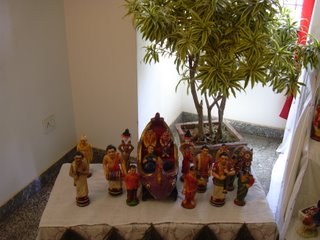

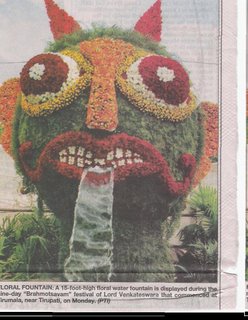
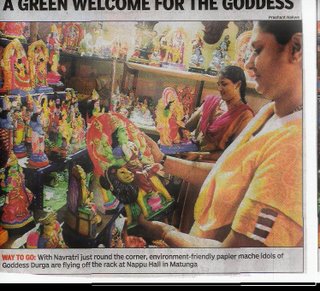
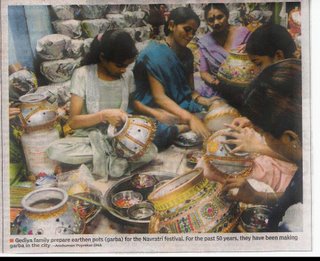

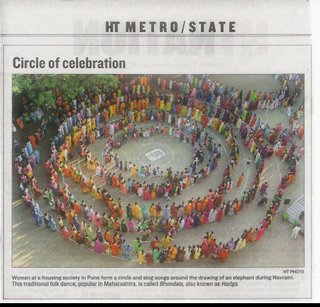
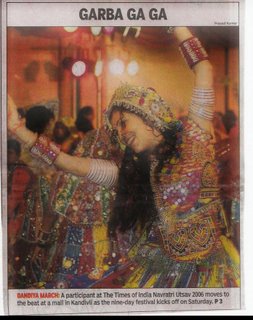


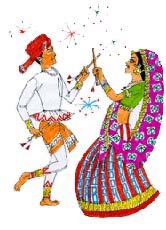

Navarathri(nine auspicious nights) has arrived.On the first day after Amavasya(new moon) with the completion of the Pitrupaksha(sraddha for ancestors) period,starts the festival of nine nights.Eagerly awaited by children and women. And men too. The festival celebrates the triumph of good over evil. The killing of the buffalo-headed demon Mahisasura by Durga(Shakthi). Hence Shakthi is worshipped during this period. Not Durga alone but Saraswati and Laksmi as well.Lakshmi on the first three days,Durga on the next three days and Saraswati on the last three days. This reminds me of the Mahalakshmi Temple at Mumbai where in the main sanctum sanctorum there are three idols.Mahalakshmi in the centre flanked by Parvati on one side and Saraswati on the other. These three are not different Devis but one Devi worshipped in three different forms or aspects. In the famous Mookambikai Temple in Kerala,the same idol is dressed up differently every eight hours throughout the year as Saraswati,Lakshmi and Parvati.The triumvirate so to say,the consorts of Brahma,Vishnu and Siva. On the ninth day,Ayudha(weapons) Pooja is performed. Saraswati is worshipped and it is also the day when tools and instruments are placed before the Goddess and allowed to remain so till the next day which is Vijaya Dasami.The tenth day is a very auspicious day for commencement of all good activities.
Referred to as Navarathri and Dassera throughout India,it is one of the most popular festivals combining worship with fun and social interaction .In Bengal these nine nights resound with devotion and dedication to Goddess Durga. In the 16th century a well-to-do landlord Kans Narayan initiated the performance of Durga Puja in Bengal.The various forms of Durga are worshipped with their respective yantras.Barley is sown in homes as a symbol of the creative power of the mother Goddess.Traditionally,little girls are symbolically worshipped on the ashtami(eighth) day,in recognition of the importance of of Shakthi or feminine force. In Mysore,Dussehra celebrations are huge and supported by the Maharaja .In the North it is celebrated with enactments of Ramleela and the burning of the effigy of Ravan on the 10th day symbolising the triumph of good over evil.The Lav-Kush Ramlila committee which has organised Ramlila at the Ramlila grounds all these years will show live 30 minutes clip on the internet for all the ten days.There are more than 350 Ramlilas organised in delhi alone.They cost anywhere between a few lakhs to a crore. The idols of the Goddess Shakthi are immersed in water on the 10th day. In Gujerat it is the very colourful garbha and dandiya that dominate the festival period till the wee hours of the morning.In Maharashtra women form a circle and sing songs around the drawing of an elephant.This traditional folk dance called 'Bhondala' is also known as 'Hadga'.
In Tamil Nadu, there is a 500 years tradition of celebrating the display or "kolu"(also spelt golu) festival.This can be traced back to the Vijayanagar kings and the royal families of Thanjavur and Pudukottai. In this festival,in every home, dolls are arranged on steps in the form of a staircase.These steps or "padis" are odd in number-7 or 9 or 11.Stacked up in 'trunk pottis' and put aside in the loft,these fascinating dolls emerge once a year to the glee of all agegroups alike.They are carefully dusted,cleaned and in some cases even painted. Passed on from generation to generation,these dolls become alive for these nine nights.The children put in a lot of efforts to make some special sets.Waterfalls or fountain. (Starting from a kalasa(pot) in the centre on the first step,dolls of gods and goddesses are arranged.These are made of wood.stone,paper mache or ceramic. There are sets or themes which are also arranged.The traditional lamp(kuthivilakku) is lit and rangoli(kolam) is drawn on the floor. In our younger days,the sets were those of a brahmotsavam or garudotsavam(special annual festivals) in a vishnu temple,the crowning of lord rama,the potbellied smiling chettiar and even the laughing buddha,the marriage of meenakshi to sundreshwar(meenakshi kalyanam)the message of the gita or some such religious/mythological background.Also,a pair of wooden dolls(a boy and a girl) called marapaachi is gifted by the parents to the daughter at the time of marriage and she is expected to continue the tradition of kolu with this "joda".As times changed,the subjects of these sets also underwent transformation.Marriage preocessions,parks,cricket match,,zoos etc gained popularity. Like in Bihar where Lalu dolls are a hit,in the South this year President Kalam has become a craze.The 'missile man' is shown surrounded by missiles.Or firing missiles and igniting the minds of the youth. And it costs Rs 450/set.Though costlier than the Lalu set,Kalam has ignited the minds of the kolu buffs and their response is immense.Not very far behind in popularity is Chief Minister Karunanidhi.The people are happy with him because he is keeping his election promises.Rice at rs 2/kg and free colour tv sets for the poor.Sets of Karunanidhi are flying off the shelves.
This is a woman's only function.Invitations are sent both by word of mouth as well as by invitation cards saying Mrs So and So invites Mrs So and So for 'Haldi Kumkum' between 7pm and 9 pm. At the end of the evening,an aarti is done and "sundal" specially made for the occasion is distributed and as the lady guest bids goodbye she is given a "taamboolam". consisting of a blousepiece,betel-leaves and supari,a comb,a mirror and two small dabbas containing haldi and kumkum both known for their auspiciousness. On the ninth night after the pooja and distribution of sweets,the dolls are put to sleep.The next morning they go back to their abode- the trunk potti. Awaiting to be woken up before the next navarathri.
Interestingly, the tradition of the festival of dolls is prevalent in Sri Lanka and Japan as well.The Japanese call it "Hina Matsuri"(the doll festival").It is a girl's festival celebrated on 3rd March every year .The girls have a party when sweet mild rice wine and rice cakes are distributed.The dolls are figures of Japanese court personages.Starting with the Emperor and the Empress.
Like in Ganeshotsav in Maharashtra where sarvajanik(common) pandals are quite popular, "community kolus" have become very common in Tamil Nadu among those who are interested but do not have the wherewithal.They come together cutting across caste and community and economically manage the "kolu festival". Even Muslims participate in "kolu" and dandiya/garbha.
Our family has a temple worship every year on the third night at the Sri Varadarajaswamy Temple at Kancheepuram. We have been sponsoring this festival for the last thirty years and enjoy the permanent rights of doing so. I have attended the function every year from its inception save on one or two occasions. We used to celebrate the kolu every year for many years at our home.This year, I happened to be in Bangalore on the fourth day and enjoyed the kolu organised by s's sister. I took some pictures on this occasion which I have featured in this blogposting. Kolu brings with it many happy memories.The mix of devotion and fellowship has its unique charm. Needless to say,besides the excitement of watching the individual dolls and other sets,the 'sundal' and sweets prepared every evening can make even the diehard's mouth salivate.
The great goal of life according to Vedanta is the attainment of bliss by knowing the self.This spiritual emancipation is known as God realisation or moksha. Our ancient sages have suggested various techniques to achieve this goal. To put it simply, it is worship for obtaining divine grace.
An interesting topic came up for discussion the other day. It is a woman's festival,the female embodiment of the Supreme is worshipped .But then lot of injustices are done to the girl child,dowry and other pernicious practices are rampant and even 'sati' in some places. Isn't this an anachronism,someone asked. Well he is right. We have many contradictions in our religion, nay way of life .But the best part of it is that inspite of these socalled aberrations we pursue our goal because of our strong faith in our 'sanatana dharma'.May Mother goddess bestow us with wealth,prosperity and knowledge and protect us from all evil.

4 comments:
i have read plenty of books on greek mythology but unfortunately not one on indian mythology. uncle could you recommend a book on indian mythology? i really want to know all about our gods and goddesses and all those quaint and impossibly heroic tales.
hello rums,
i suggest you read the following two books.the first is a coffeetable book and covers the whole subject quite well.the second book is something you would probably prefer over the first.it is a novel as well as a compendium of indian myths and legends.
1) "Indian Mythology' by Veronica Ions published by Newnes Books,UK
2)'Ka" by Roberto Calasso originally writtten in Italian and translated onto English by Tim Parks.Published by Vintage,UK.
The pictures simply took my breath away! How very wonderful the tradition of "kolu" seems to be. One day I would love to do something like this for my kids!
Honestly, your blog is such a godsend - I have learned so much about the festivals by coming here . I just wish so much I had seen this post earlier, so that I could have visited our temple on "Vijaya Dasami". I feel terrible that I missed it, but it's my fault for not regularly checking the Hindu calender.
Am going to reread this post - I have really enjoyed it, thank you!
p.s. I have had Roberto Kalassa's "Ka" sitting on my bookshelf for the longest time - this seems like a good time to delve into it.
Who knows where to download XRumer 5.0 Palladium?
Help, please. All recommend this program to effectively advertise on the Internet, this is the best program!
Post a Comment